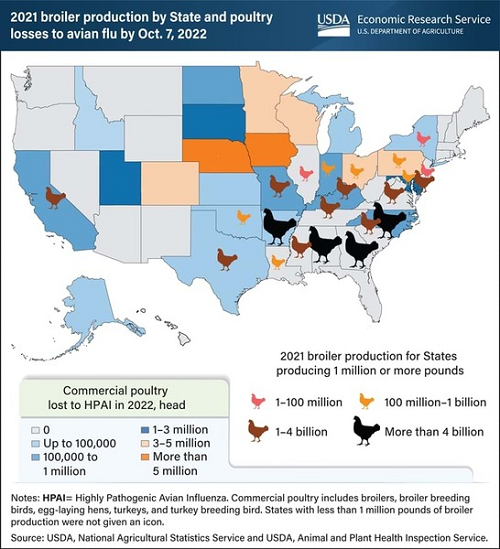Bird Flu, or a particularly pathogenic version of Avian Influenza A (H5N1) is spreading around the world. Currently we know about 145 cattle herds and 4 farm workers in a dozen states across the United States but that is likely the tip of the iceberg.
It was detected in poultry in China in 1996, and had spread to wild birds by 2002. It then spread around the world on their migratory routes, and in 2021 it entered the US. It has been spreading around the large scale intensive poultry enterprises, and at some point started infecting dairy cattle. Transmission in cattle within the head is via milking machines (Caserta 2024) and between herds includes the movement of asymptomatic cattle (Nguyen 2024). The milk could provide a potential route of human infection. It also infects other mammals, including cats (2 died!) and also a significant outbreak in harbor seals as well as a long list of others.
The World Health Organization (WHO) has reported a total of 860 human infections with 454 fatal cases since 2003, though this should not be interpreted as a true case fatality ratio as less severe infections are likely to go unreported. The worry that it could be only one mutation from efficient human-human transmission and another global pandemic. The 2009 pig flu had a relatively low mortality rate by flu pandemic standards, being estimated to have killed less than 300,000 (Dawood 2012). The Spanish Flu probably killed more than WW1 [BBC].
Any thoughts? Are we better or worse off since COVID? Will our familiarity with flu jabs protect us from some misinformation?
Spread Around the World (I am not sure how to interpret b) (Ramey 2022) :

I cannot find a reference for this, but I think it is roughly right:

Note the date, but gives an idea where the US poultry herd is:

Source
Nature Review on International preparedness 12th July
Nature Review on spread in US herd 8th May
Ramey 2022 : Highly pathogenic avian influenza is an emerging disease threat to wild birds in North America
https://doi.org/10.1002/jwmg.22171
Dawood 2012 :Estimated global mortality associated with the first 12 months of 2009 pandemic influenza A H1N1 virus circulation: a modelling study
https://doi.org/10.1016/S1473-3099(12)70121-4
Caserta 2024 : From birds to mammals: spillover of highly pathogenic avian influenza H5N1 virus to dairy cattle led to efficient intra- and interspecies transmission
https://doi.org/10.1101/2024.05.22.595317
Burrough 2024 : Highly Pathogenic Avian Influenza A(H5N1) Clade 2.3.4.4b Virus Infection in Domestic Dairy Cattle and Cats, United States, 2024
https://wwwnc.cdc.gov/eid/article/30/7/24-0508_article
Nguyen 2024: Emergence and interstate spread of highly pathogenic avian influenza A(H5N1) in dairy cattle
https://doi.org/10.1101/2024.05.01.591751
Uyeki 2024 : Highly Pathogenic Avian Influenza A(H5N1) Virus Infection in a Dairy Farm Worker
https://www.nejm.org/doi/10.1056/NEJMc2405371
It was detected in poultry in China in 1996, and had spread to wild birds by 2002. It then spread around the world on their migratory routes, and in 2021 it entered the US. It has been spreading around the large scale intensive poultry enterprises, and at some point started infecting dairy cattle. Transmission in cattle within the head is via milking machines (Caserta 2024) and between herds includes the movement of asymptomatic cattle (Nguyen 2024). The milk could provide a potential route of human infection. It also infects other mammals, including cats (2 died!) and also a significant outbreak in harbor seals as well as a long list of others.
The World Health Organization (WHO) has reported a total of 860 human infections with 454 fatal cases since 2003, though this should not be interpreted as a true case fatality ratio as less severe infections are likely to go unreported. The worry that it could be only one mutation from efficient human-human transmission and another global pandemic. The 2009 pig flu had a relatively low mortality rate by flu pandemic standards, being estimated to have killed less than 300,000 (Dawood 2012). The Spanish Flu probably killed more than WW1 [BBC].
Any thoughts? Are we better or worse off since COVID? Will our familiarity with flu jabs protect us from some misinformation?
Spread Around the World (I am not sure how to interpret b) (Ramey 2022) :

Spoiler Legend :
Occurrence of outbreak events for highly pathogenic avian influenza (HPAI) in wild and captive birds (i.e., non-poultry) from 2 August 2005–22 March 2021 as reported to the World Organisation for Animal Health (OIE). Panel A depicts the relative occurrence of detection events (red) geographically during the period following spread of emergent A/goose/Guangdong/1/1996-like (GsGD) highly pathogenic HPAI viruses to wild and captive birds (left) and subsequent to the evolution of clade 2.3.4.4 viruses (right), many of which may be adapted to wild birds. Panel B depicts the relative occurrence of HPAI outbreak detections by year. Data courtesy of the World Organisation for Animal Health (OIE 2021a)
I cannot find a reference for this, but I think it is roughly right:

Note the date, but gives an idea where the US poultry herd is:

Source
Nature Review on International preparedness 12th July
Nature Review on spread in US herd 8th May
Ramey 2022 : Highly pathogenic avian influenza is an emerging disease threat to wild birds in North America
https://doi.org/10.1002/jwmg.22171
Dawood 2012 :Estimated global mortality associated with the first 12 months of 2009 pandemic influenza A H1N1 virus circulation: a modelling study
https://doi.org/10.1016/S1473-3099(12)70121-4
Caserta 2024 : From birds to mammals: spillover of highly pathogenic avian influenza H5N1 virus to dairy cattle led to efficient intra- and interspecies transmission
https://doi.org/10.1101/2024.05.22.595317
Burrough 2024 : Highly Pathogenic Avian Influenza A(H5N1) Clade 2.3.4.4b Virus Infection in Domestic Dairy Cattle and Cats, United States, 2024
https://wwwnc.cdc.gov/eid/article/30/7/24-0508_article
Nguyen 2024: Emergence and interstate spread of highly pathogenic avian influenza A(H5N1) in dairy cattle
https://doi.org/10.1101/2024.05.01.591751
Uyeki 2024 : Highly Pathogenic Avian Influenza A(H5N1) Virus Infection in a Dairy Farm Worker
https://www.nejm.org/doi/10.1056/NEJMc2405371
Last edited:





